To access the online database, click below:
During the period from the late 1800s to the outbreak of World War I in 1914, over 50,000 Armenians immigrated from their homeland to North America. Most of them came from the Ottoman Empire (eastern Turkey) to New York's Ellis Island (which opened in 1892). Some were in transit to Canada (primarily to manufacturing towns like Brantford and Hamilton in Ontario); others were destined for manufacturing jobs in the USA in places like New York City, Providence, RI, Troy, NY, E. St. Louis/Granite City, IL, and Detroit, MI, or to settle in rich farmland like California's San Joaquin Valley. These immigrants were predominantly men, many of whom went back and forth between North America and their Armenian homeland several times. Almost all of them traveled in 3rd class, or steerage. Some wives and children also came to join their husbands and fathers and settle in North America.
As the conditions for Armenians in the Ottoman Empire worsened during the period between the 1890s and 1908 (culminating in the "Young Turk" revolution and the Adana massacre) and the Balkan conflicts of 1912-1913, the number of Armenian immigrants to North American increased significantly. With the outbreak of World War I on 28 July 1914, immigration of Armenians to North America slowed to a trickle. Most Armenian men in the USA and Canada were unable to return to Turkey to their families. The Armenian Genocide of 1915-1916 resulted in the eventual deaths of the majority of Armenians then living in the Ottoman Empire and the ethic depopulation of the Armenian communities in the six traditional Armenian vilayets of eastern Turkey (Van, Bitlis, Erzurum, Diyarbekir, Sivas, and Mamuretulaziz). After the end of the War in 1918, some of those few who survived the massacres managed to join their families in North America and Europe.
With the destruction of the Armenian homeland, most of the civil and ecclesiastical records were lost forever. This makes it very difficult for many Armenians living today to learn about their family's genealogical and historical background. Fortunately, there are rich primary sources of historical information pertaining to Armenian immigrants to North America in the form of ship manifests, census records, World War I draft registrations, vital records, naturalization records, passports, newspaper advertisements, etc.
This web site introduces a new historical research project (started in 2011) to transcribe the manifests of the passenger ships bringing Armenian immigrants to North America. In 2001, inspired by the works of Robert Mirak (Torn Between Two Lands) and Isabel Kaprielian-Churchill (Like Our Mountains, A History of Armenians in Canada), I transcribed 2,664 ship manifest entries for Armenians from the kaza (district) of Keghi in the vilayet of Erzurum. (My paternal grandfather Dikran Arslanian came to the USA in 1906 from the village of Sergevil in that district.) I have now expanded that project to begin transcribing ship manifests for all those of Armenian heritage coming to America.
Based on the more than 125,000 Armenians who immigrated to America before 1930, transcribing that many ship manifest entries will be a monumental task, involving many people over several years. To initiate that process, I have created software tools to facilitate the collaborative transcription of these records, ship by ship, as well as the analysis of the data to produce a number of standard queries and reports to present this information in a useful and interesting fashion. The results of this endeavor can then be correlated with similar efforts to transcribe other significant primary sources like USA and Canadian census records. The overall objective is to provide a reference to allow those of Armenian descent in North America to identify their immigrant ancestors and relatives to learn more about their heritage and linkage to the Armenian ancestral homeland.
At this point, we have abstracted 76,231 entries from 4,400 ship trips (and land border crossings) containing Armenian immigrants to North America. This represents just some of the Armenian immigrants to North America during the time period of this study. A database with all of those entries is now available online for queries and reports. The online database will be updated frequently as more entries are transcribed.
The number of people who actually entered North America is less than the number of ship manifest entries. Some of the immigrants (at least 2.4%) were immediately deported, typically for health reasons such as trachoma. Others (at least 1.7%) never boarded the ship and their names were crossed out. We often find that those who were deported or didn't board the ship subsequently sailed on another ship and did successfully gain entry to either the USA or Canada. Many of the immigrants, particularly the men who sojourned prior to World War 1, travelled between the "Old Country" and North America multiple times. Therefore, the actual number of Armenian immigrants is somewhere in the neighborhood of 90% of the number of ship manifest entries.
Most of the Armenian immigrants traveled in the lowest class of accommodation (steerage). The layout of the passenger berths varied from ship to ship. Single men and women were (obviously) kept in separate sections, while another section was reserved for families. On some of the ship manifests, a sketch of the layout of the steerage section was provided for that trip. Here are some examples.
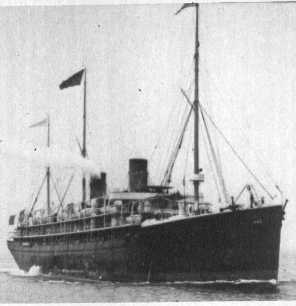

S. S. La Touraine (sailing from Le Havre, France to New York, NY, USA) with layout of steerage
section from 1896
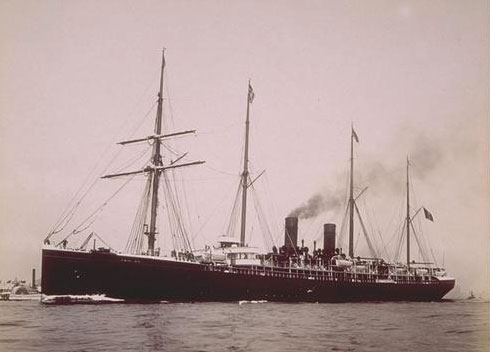
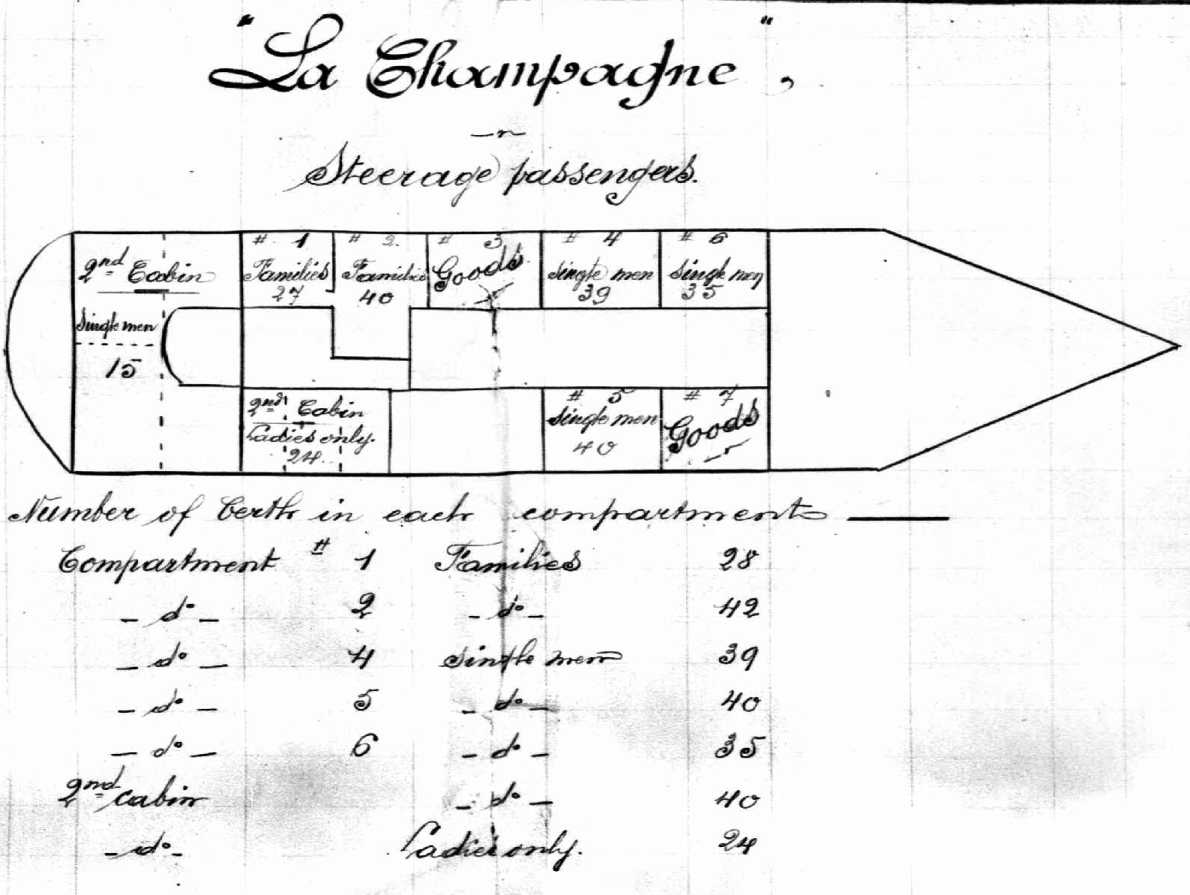
S. S. La Champagne (sailing from Le Havre, France to New York, NY, USA) with layout of steerage
section from 1896
Here is a scripted version of the presentation I gave on this project at the Armenian Genealogy Conference at Watertown, Massachusetts in April 2016:
Presentation - Armenian Immigration Project
The methodology for this study to transcribe and analyze ship passenger manifests consists of the following steps:
1. Select list to be transcribed.
2. Locate list and transcribe entries of Armenian passengers to a spreadsheet.
3. Copy the transcribed entries into a database.
4. Analyze the new data:
a. Standardize place names (towns/districts, states/provinces, countries, streets).
b. Standardize last names (surnames).
5. Upload reports to web site.
A significant amount of information can be gleaned from the manifests. The detail on the earlier manifest forms was minimal, but the later forms, particularly after 1907, contained a lot of data relating to the immigrant's life in both the old and new worlds. Much of the information in my database of Ship Manifests is arranged by the "standardized" last name, then by first name. Why the standardized last name? The ship passenger manifests were standard forms that were filled out by the shipping companies at the port of origin prior to embarking on the voyage (typically from Europe) to North America. These manifests were prepared by employees of the shipping companies and then presented to the immigration authorities (e.g., at Ellis Island in New York) at the destination port when disembarking, so that they could process the immigrants.
As you can imagine, recording a family name like  into a Latin script can
yield a number of different spelling variations, like Hakobian, Akobyan, Akobian, Hagopyan, Hagopian, Agopyan, Agopian, Acopyan, Acopian, Akopyan, etc. (The English
equivalent would be Jacobson, James, etc.) When transcribing the manifests, I record the names exactly as written to preserve the original transliteration.
However, there is value in grouping similar names together in the reports so that you can find your immigrant or, perhaps, groups of
related immigrants. For each surname, I have attached a "standardized" version of that surname (in brackets), typically based on the most common
spelling found in North America or Europe for "western" Armenians (those from the former Ottoman Empire). Those same surnames are
often transliterated differently for those immigrants from the part of Armenia formerly under Russian dominion ("eastern Armenians"),
where the present-day country of Armenia exists. Since most of the Armenian immigrants to North America of the late 1800s and early 1900s were
of the "western" variety, I've chosen to standardize the surnames with that dialect. This is not to say that the standardized name
is more correct than other spellings; it is just a way to group names together that have the same etymology and were probably spelled
the same in Armenian.
into a Latin script can
yield a number of different spelling variations, like Hakobian, Akobyan, Akobian, Hagopyan, Hagopian, Agopyan, Agopian, Acopyan, Acopian, Akopyan, etc. (The English
equivalent would be Jacobson, James, etc.) When transcribing the manifests, I record the names exactly as written to preserve the original transliteration.
However, there is value in grouping similar names together in the reports so that you can find your immigrant or, perhaps, groups of
related immigrants. For each surname, I have attached a "standardized" version of that surname (in brackets), typically based on the most common
spelling found in North America or Europe for "western" Armenians (those from the former Ottoman Empire). Those same surnames are
often transliterated differently for those immigrants from the part of Armenia formerly under Russian dominion ("eastern Armenians"),
where the present-day country of Armenia exists. Since most of the Armenian immigrants to North America of the late 1800s and early 1900s were
of the "western" variety, I've chosen to standardize the surnames with that dialect. This is not to say that the standardized name
is more correct than other spellings; it is just a way to group names together that have the same etymology and were probably spelled
the same in Armenian.
I have made no attempt to standardize the first names. They are transcribed exactly as spelled (or, more often, misspelled) in the original manifest.
Likewise, spelling of place names on the lists varied significantly, both the names in the immigrant's homeland as well as their destination in North America. For those ships leaving from France, the place names were often spelled the way that French would write or pronounce the name: Alexandrie for Alexandria, or Keri/Kighi/Curry/Khegi/Kigi/Kghi for Keghi. American street names and names of cities were similarly subject to variation in spelling. So, I standardized all place names in the database. For the immigrant's birthplace or place of last residence, or the location of the "leaving" friend or relative, the place name given was often the nearest large city or district (kaza). If these places were in the part of the Ottoman Empire that corresponds to present-day Turkey or the Middle East (Syria and Mesopotamia), I determined the Ottoman vilayet at the time of immigration and included that in the database. The administrative divisions in the Ottoman Empire in the period just prior to World War 1 were (in order of increasing size): kaza, sanjak, vilayet. A kaza corresponds to a county in the USA and Canada, while a vilayet is the equivalent of a state or province. The sanjak is roughly analogous to a region of a state/province, perhaps California's Central Valley.
For place names, it was not always possible to distinguish between the name of a town or kaza or sanjak and the vilayet in which it was located, if they were the same name (e.g., Erzurum, Sivas, Adana, Aleppo, Bitlis, Van, Mamuretulaziz, etc.). Someone who gave their place of birth as Sivas may actually have been referring to the vilayet and not the town/kaza/sanjak. In these reports, where this ambiguity occurs, I have shown the name as that of the vilayet (e.g., Sivas, Turkey), but keep in mind that the actual town/kaza/sanjak may be somewhere else in the vilayet than the administrative capital (like Gurun in the case of Sivas). The form of the place names in Turkey in these reports is usually shown as "kaza, vilayet, Turkey" (e.g., "Keghi, Erzurum, Turkey"). If the name of the town or village is given in the record, I'll show it in the form "Keghi (Sergevil), Erzurum, Turkey", meaning the village of Sergevil in the kaza of Keghi, in the vilayet of Erzurum, in Turkey. I omit sanjak names in this hierarchy, in the interest of simplicity and space (the exception being autonomous sanjaks like Urfa and Marash).
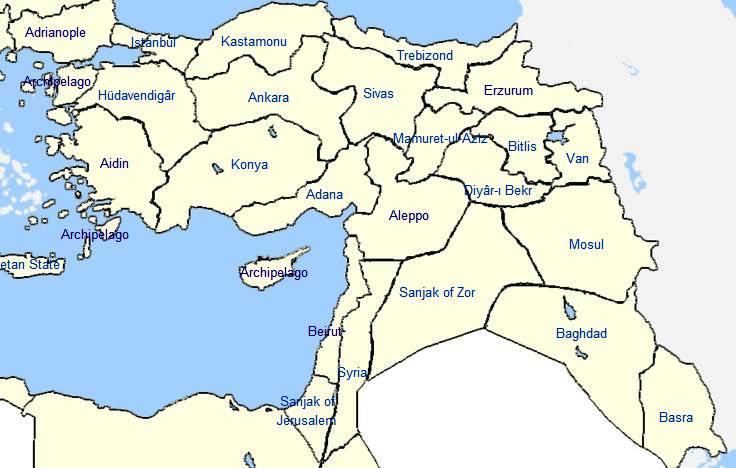
Ottoman Vilayets (ca. 1900) from Wikipedia (click on picture to go to web site)
By 1907, the immigrants were asked to provide information about themselves (name, age, sex, occupation, place of last permanent residence, birthplace, whether they had been in the USA or Canada previously, etc.), the name and location of the "nearest relative or friend in country whence alien came", and "whether going to join a relative or friend" in North America. The street address, city, and state/province of that "joining" relative or friend was recorded. This linkage of "leaving" friend or relative to the immigrant to the "joining" friend or relative is one of the useful features of the manifests, information rarely found in other documents, perhaps the last recorded linkage to their places of origin and to those who perished in the Armenian Genocide (1915-1916). There are a number of other fields on the forms that are not included in this transcription, but may be worth investigating later for a particular individual.
To allow the immigrants to be referenced individually (perhaps from another database), I have assigned to each immigrant a unique "Immigrant ID" (below). This ID can be used to easily find that immigrant on the appropriate ship list. On the reports, I have indicated the Immigrant ID of the "joining" friend or relative (if known) in brackets after that person's name. Sometimes the "leaving" friend or relative subsequently immigrated themselves, in which case their Immigrant ID is listed in brackets after their name. Sometimes immigrants had already been in the USA or Canada previously. Other Immigrant IDs for that person are also shown in brackets after the Immigrant ID for the listed trip.
Several different ship manifest forms were used by USA immigration, depending on the year of the trip and the immigration legislation then in effect. The forms differ in the types of questions asked of the immigrants. In general, the later forms contain more useful information. Form 500, which came into use in early 1907, has two pages of questions, with 30 immigrants per page. Sometimes additional information was written or stamped on the form, including in the margins, by the immigration officials at the destination port (e.g., Ellis Island in New York). See A Guide to Interpreting Passenger List Annotations (by Marian L. Smith, Historian, U.S. Immigration and Naturalization Service). For example, "S. I." means that the immigrant was held for "Special Inquiry" (often for a medical condition). A small number of immigrants were deported (sent back to Europe on the next ship). (Often, that same immigrant took another ship back to North America a short time later.)
These form numbers (below) are not the official designations. They are just the informal labels I've used for the different types of forms. (Click on the thumbnail image for each form to get a higher resolution image where you can view the format in detail.)
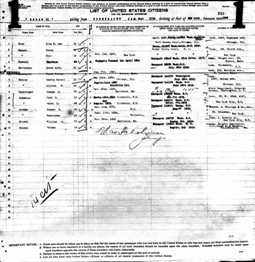
"Form 630 (List of United States Citizens)"
Original images of the ship passenger manifests can be found at these sites. Ancestry.com requires a fee subscription, but the search capability and image viewers are worth it. The Ellis Island site is free. Stephen P. Morse has created some powerful search tools for several of the immigrant sites: Stephen P. Morse Search Tools
Ancestry.com - Immigration & Travel
Ellis Island Foundation
For each ship that brought Armenian immigrants to North America, one spreadsheet (or workbook) will be created to record entries from that ship's passenger manifests for all trips, one sheet within the workbook per trip. The destination date of each trip is used as the label for the sheet's tab. At the back of the workbook are individual template sheets for each of the form types (above). Here are sample data entry workbooks I have created (in both .ods and .xls formats):
Sample Input Form (OpenDocument format, .ods)
Sample Input Form (Microsoft Excel format, .xls)
Once a trip is recorded for a ship (one with Armenian immigrants), a program (written in Open Object Rexx, or ooRexx) converts the transcriptions into a "comma-separated variable" (.csv) text file, which is then imported into the project database (using mysql). I have written several routines in the PHP scripting language to allow everyone to query this database by a variety of search criteria to find information about their research interests.
To access the online database, click below:
These immigrants traveled mostly (91.0%) in 3rd-class (steerage). They were predominantly (69.2%) male. The most common destination state/province was New York (28.9%), followed closely by Massachusetts (26.8%), with New York (Manhattan) (20.6%) being the locale receiving the most Armenian immigrants. The top destination address was 98 Common Street in Lawrence, Massachusetts (0.7%). However, the Malleable Iron Co. was listed as the destination address for a little over 1.9% of the immigrants, with locations including E. St. Louis (IL), Troy/Watervliet (NY), Brantford (ON), and Detroit (MI). The Ottoman vilayet of Mamuretulaziz (where the city of Harput is located) was the most common place of last permanent residence (16.8%). (Most of the ships whose lists have been searched so far originated in French ports. A broader sampling including other ships from other points of origin will give use a more complete picture.)
The demographic profile of the Armenian immigrants arriving in North America changed with the dynamic geopolitical events of the time. This chart shows the relative percentages of Armenian immigrants to America in each year from 1900 through 1923, broken down by sex and age (adults over 18 and minors). Prior to 1908, you see slightly around 55% men over age 18 (dark blue), with a decent mix of women (dark red), boys (light blue), and girls (light pink). With the Young Turk revolution of 1908 and the Adana massacre of 1909, the mix changed predominately to adult men. This continued until the start of WW1 in 1914. Overseas travel from Turkey for Armenians was severely constrained during the war; the relative percentages in this time period were based on much lower absolute numbers, and were primarily people who had left Turkey before the war (and genocide) for Europe or Russia. Once the war ended and travel to America resumed in 1919, you see a huge demographic shift to women and children. The few men in the mix are mostly those who were in America when the war started, going back to Turkey to bring back their surviving family members or new brides.

Far fewer of these survivors of the genocide were from the interior Ottoman vilayets. A far smaller proportion of those born in Erzurum, Van, Diyarbekir, or Bitlis were represented in the ship manifests after the war. The place of last residence for those arriving after 1919 was more likely to be Aleppo, Ayntab, Smyrna, or Constantinople, or even outside of Turkey (especially Greece, France, or Russia), often where they found refuge with the Allied Powers occupying the defeated Ottoman Empire.
Armenian communities in different parts of America have their own unique demographic makeups in terms of birth place of the immigrants. (See chart below.) Philadelphia is comprised heavily of those from the vilayet of Mamuretulaziz; Wayne County, Michigan (Detroit, Highland Park, and Dearborn) has the most from Erzurum, and California's San Joaquin Valley (Fresno and outlying farming towns) has many born in Bitlis. And where did most of the Armenians from Russia settle? In Los Angeles, California.
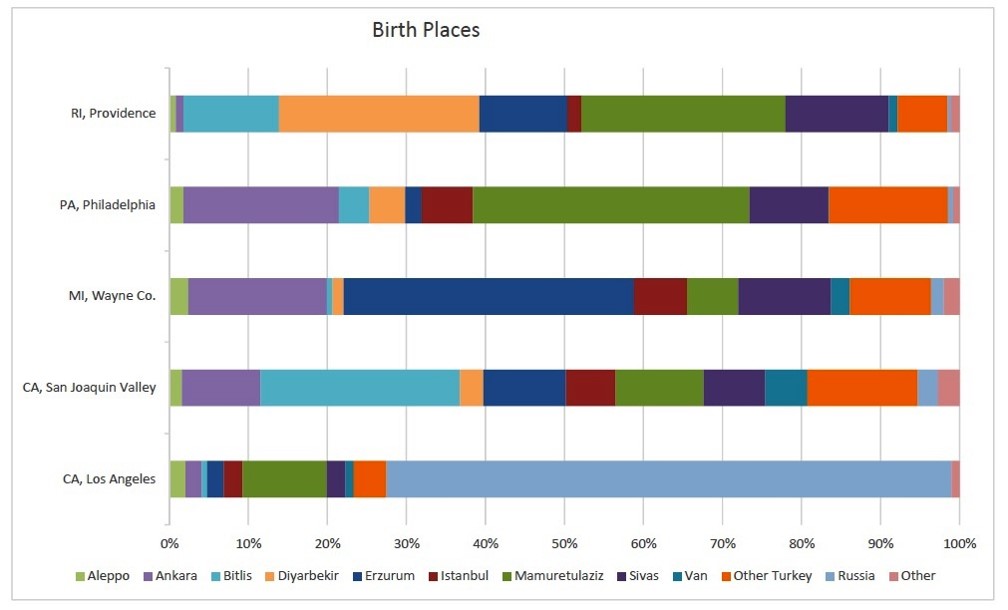
Ship Immigrants Search Results
This is a listing of the ships and trips that have been searched so far, indicating whether they have been included in the reports shown above.
Export of Entire Database
This .csv file contains the entire online database. You
may import this file into your own spreadsheet program or database to create your own reports or do your own analysis. The character set
is utf-8 and the column separator is a semicolon (;).
As I've stated earlier, transcribing over 75,000 entries is too big for one person to accomplish alone (particularly one with a full-time job). I am seeking volunteers with experience using spreadsheets (Microsoft Excel), who have an eye for detail, are particular about accuracy and can follow a predefined format, have an intellectual curiousity about history and people, with a lot of patience. (Reading these entries can be a bit tedious; break up your work into bite-sized chunks.) If someone wants to just try out transcribing a trip or two to see how it goes, I'd be happy to assign one to you. Perhaps you can transcribe the trips on which your immigrant ancestors came to North America.
In many of the ship lists, the immigrants were grouped by ethnicity, so most of the Armenians are listed on the same page or adjoining pages, mostly in steerage. When transcribing a trip, it is important to read all list pages for that trip (including Saloon/First-Cabin and Second-Cabin), just to make sure we've found all the Armenians and can check that trip (for that ship) off our list. I'll put your initials by that trip in the Ship Immigrants Search Results listing to acknowledge your contribution.
Getting used to the handwriting (letters and numerals) and being able to make out the place names and personal names takes some practice. Being somewhat familiar with Armenian surnames and given names, as well has having a working knowledge of geography (North American, European, and the Middle East) are important. I suggest getting together on the phone the first time to step through one page together. That way, I can acquaint you with the format of the original manifest form, my spreadsheet form, and my standards for data entry. (My ooRexx program that extracts the data from the spreadsheet into a .csv file expects the data to be input a particular way. Also, some fields need to be entered verbatim (exactly as shown on the manifest); others (like names of countries and USA and Canadian cities and states/provinces) can be adjusted to the standard spelling and abbreviations. USA and Canadian street addresses have to be entered in a particular format. The field descriptions and data entry instructions can be found in the rightmost sheet entitled "Data Entry Instructions" in the data entry spreadsheet.
Please send me an e-mail if you are interested in helping. This is a project I do in my spare time, so please understand if it takes me awhile to respond. Once a few of you get proficient in transcribing the data, I may ask you to help me bring others on board, get them acquainted with the process, and review their work. By dividing and conquering, we should be able to make good progress, while maintaining integrity of the data entered.
I have begun work on other databases to complement the Ship Lists. One involves the World War 1 and World War 2 draft registrations for men living in the USA, and Attestation Papers for men in Canada joining the Canadian Expeditionary Force (CEF) during World War 1. This database is especially useful in that the records occasionally provide the village of birth of the registrant, or the name and last known residence of their nearest relative (sometimes a wife in the "Old Country").
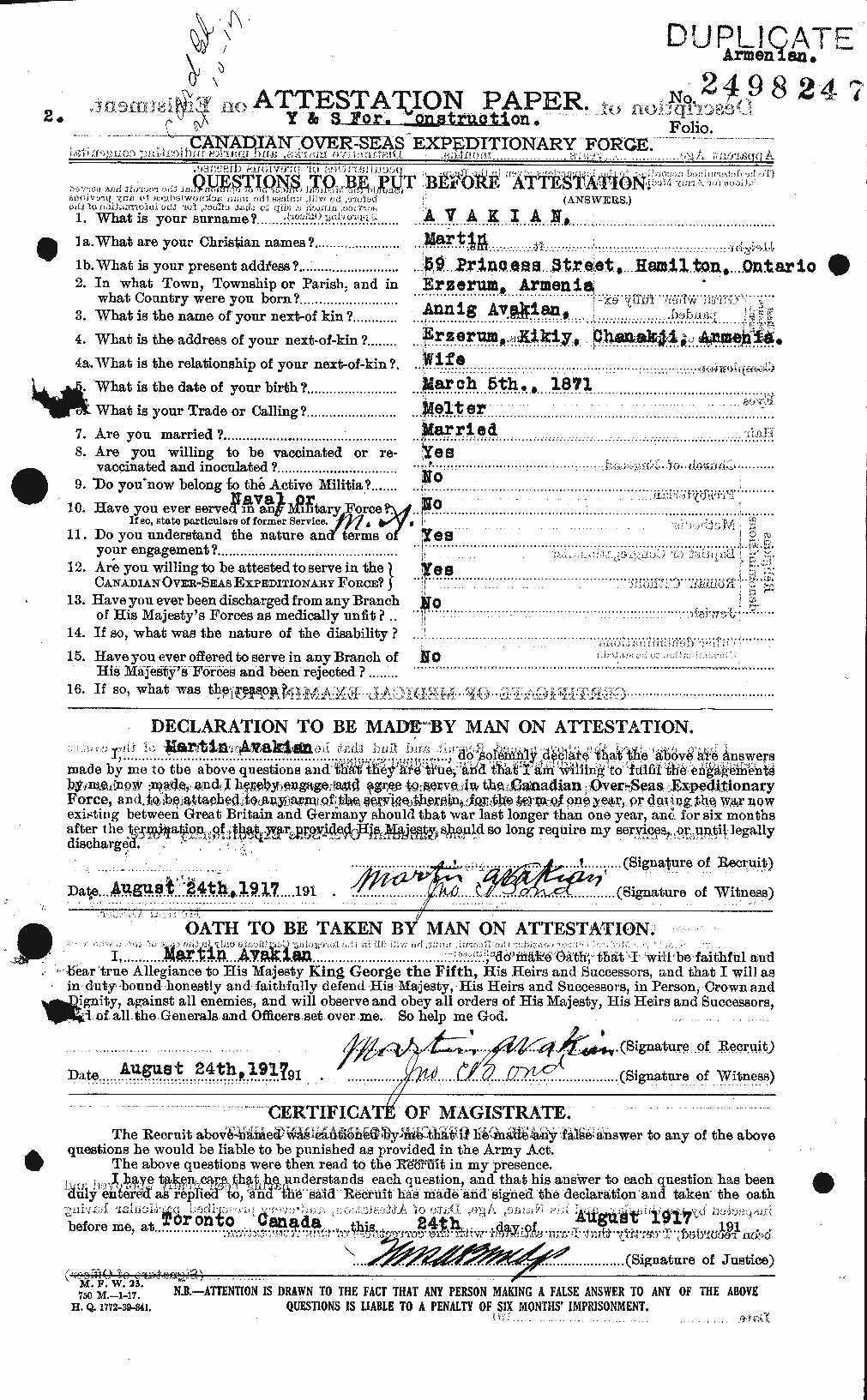
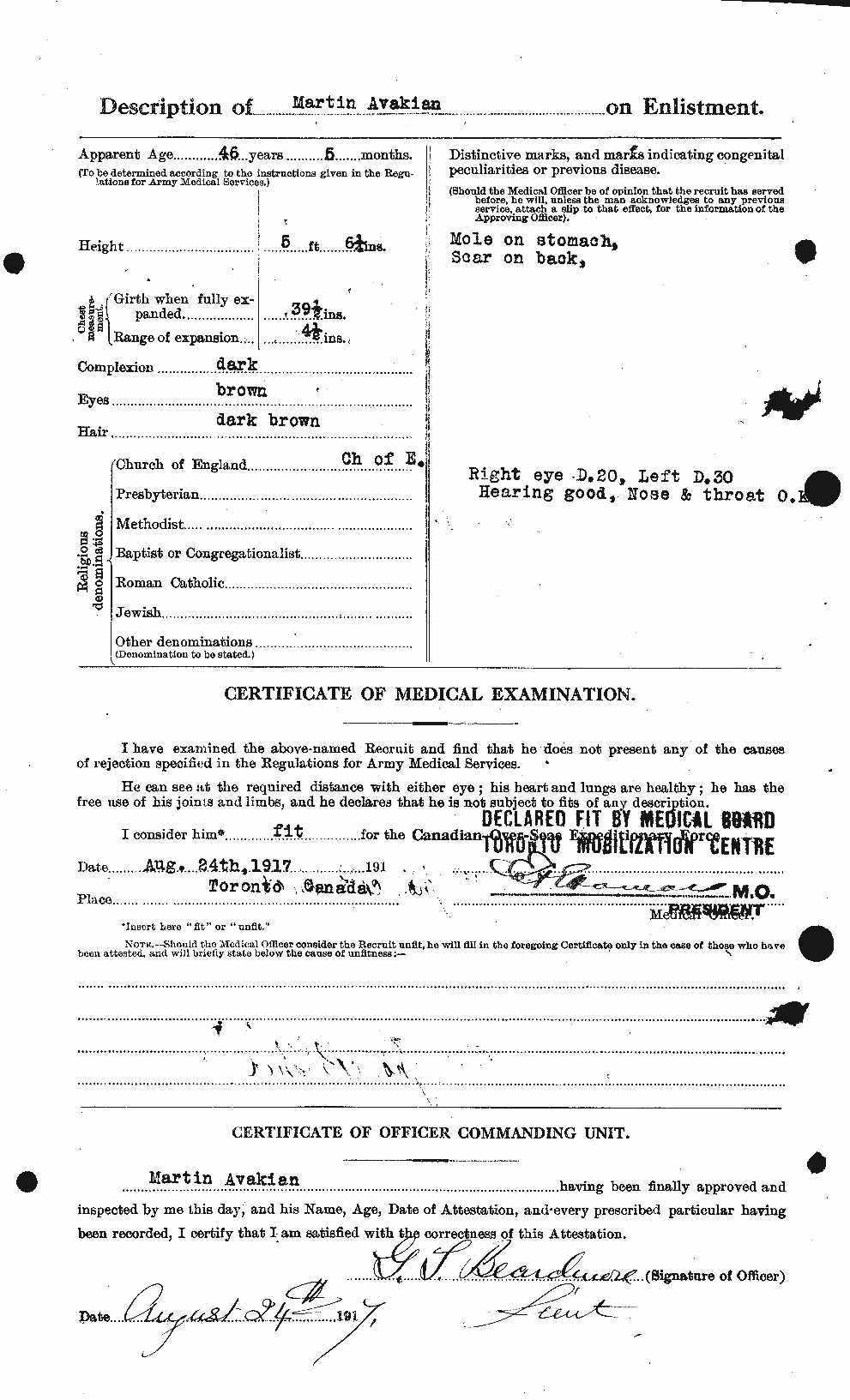
Canada's World War 1 Attestation Papers
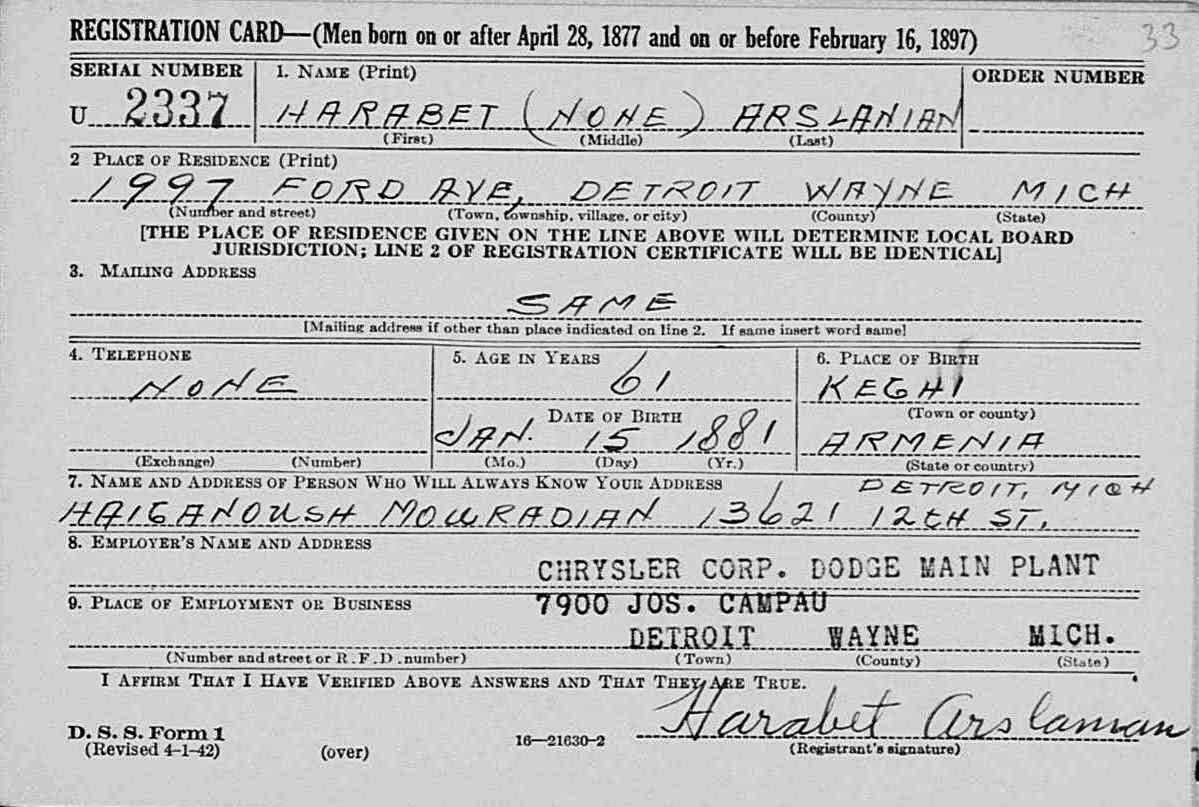
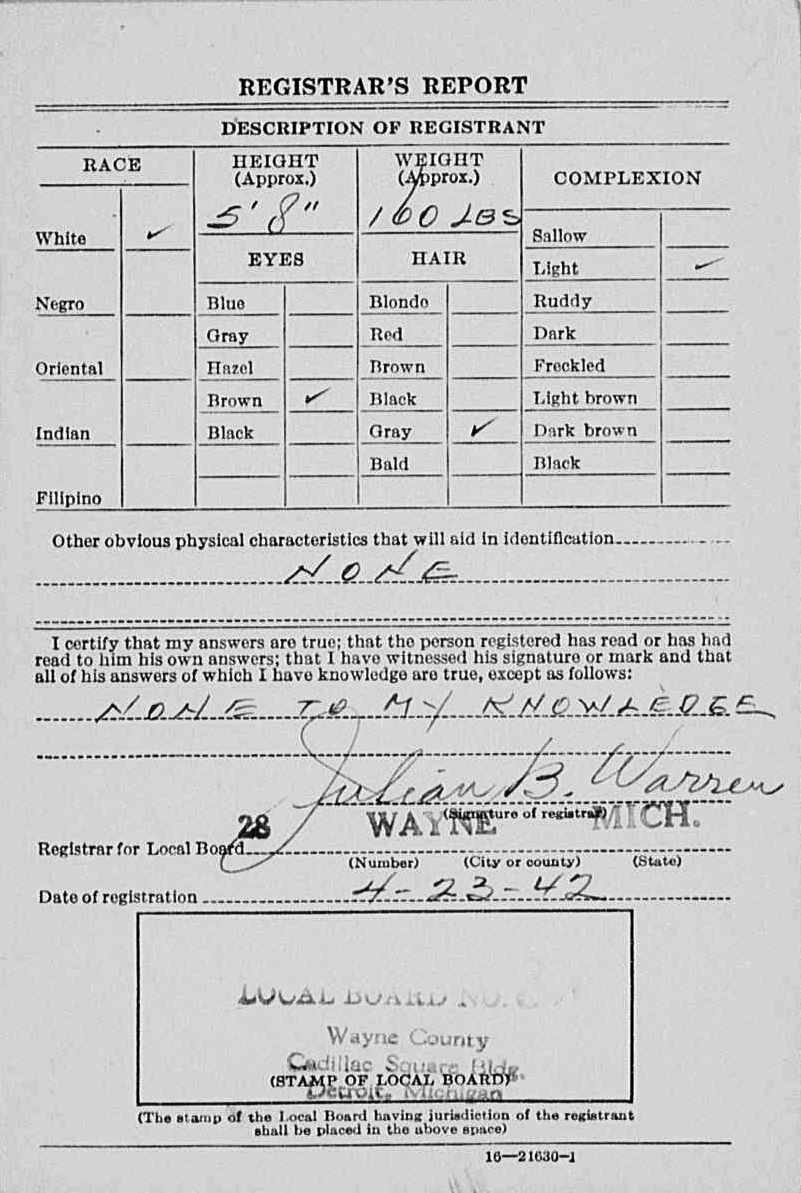
USA's World War 2 Draft Registration CardsTo access the online database, click below:
The USA started its draft registration for men of "fighting age" (those born between 1872 and 1900) shortly after it entered the war in 1917. Three different drafts were conducted in 1917 and 1918. These draft registration cards consist of three different types (A, B, and C), each slightly differing in the information presented. For example, registrants with card type A (typically registered on 5-Jun-1917) did not record their nearest relative's name and address, while registrants with card type C (typically 12-Sep-1918) listed the nearest relative's information, but not their own place of birth. Keep this in mind when analyzing the reports. For more information on the card types and information presented on each, see United States, World War One Draft Registration Cards (FamilySearch Historical Records).
The USA World War 2 draft registrations of 1942 (http://search.ancestry.com/search/db.aspx?dbid=1002) was for men born between 1877 and 1897. This is sometimes referred to as the "Old Men's Draft Registration" or the "Fourth Registration". These men were between 45 and 64 years old. This source is useful in that most of its registrants were also included in the USA's World War 1 draft registration. Some of the 1942 cards give the village or kaza of birth of the registrant. When a man appears in both the 1917-1918 and 1942 registrations, we get a more complete picture by comparing the two documents.
Birth dates are one of those problem areas in Armenian genealogy. When comparing different early primary source records for an individual, you will rarely see consistency in the birth date. Did these immigrants really know their exact birth dates? To answer this, I looked at the 7,500+ records in the Military database, and created a histogram showing the distribution of birth days across the month. If truly random, you would expect to see a fairly consistent distribution of birth days between 1 and 28, with less between 29 and 31. What I found instead was a huge spike at day 15, with lesser spikes at 1, 5, 10, 20, and 25. These men, or the clerks recording the information, were clearly rounding the days to the 15th, the 1st, or a multiple of 5. If someone only knew they were born sometime in the month of March, that got rounded to 15 March. (Maybe that is an artifact of an instruction given to the draft registrars in their training.)

Export of Entire Database
This .csv file contains the entire online database. You may import this file into your own spreadsheet program or database to create your own reports or do your own analysis. The character set is utf-8 and the column separator is a semicolon (;).
Another database is that of marriages of Armenians in the USA and Canada through the middle 1920s. The marriage records are especially important in that they often provide the names of the parents of the bride and groom (often including the maiden surnames of their mothers). Many of these men and women I was able to tie back to the Ship Manifests database. When we can find the same individual represented in multiple primary sources of that era, it often provides a much more complete picture of that individual.
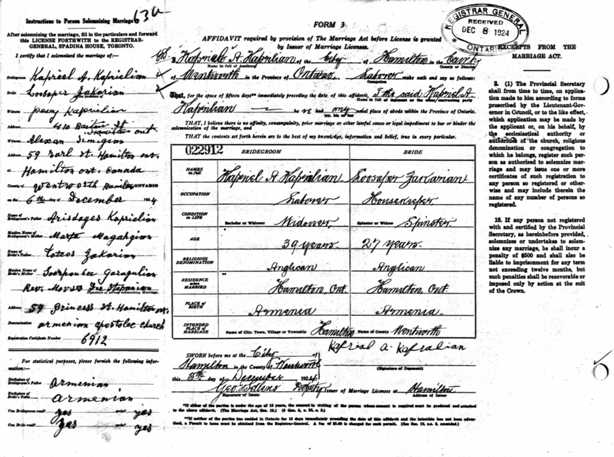
Ontario, Canada Marriage RecordTo access the online database, click below:
Export of Entire Database
This .csv file contains the entire online database. You may import this file into your own spreadsheet program or database to create your own reports or do your own analysis. The character set is utf-8 and the column separator is a semicolon (;).
Armenians started coming to America as early as the Jamestown, Virginia colony of the early 1600s. The earliest USA census showing all members of a household was in 1850 (and every 10 years thereafter). The 1890 census was almost completely destroyed in a fire, but the decennial censuses through 1940 are publicly available. In Canada, censuses starting in 1851 listed all members of the household. Decennial censuses are available publicly through 1921. An Armenian named Cricore Aram appeared in the 1850 census of Northampton, Hampshire County, Massachusetts (occupation: machinist).
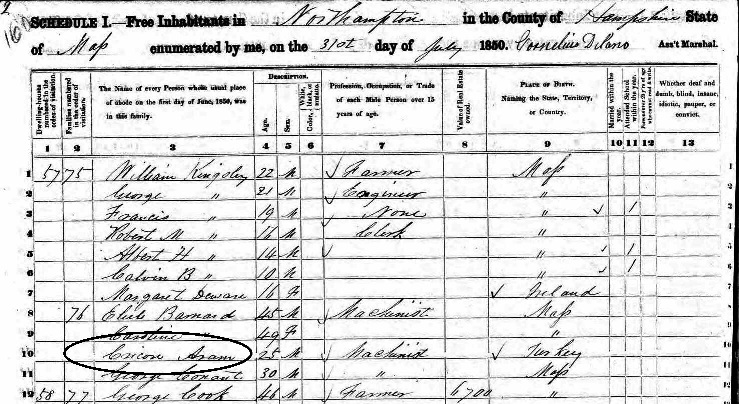
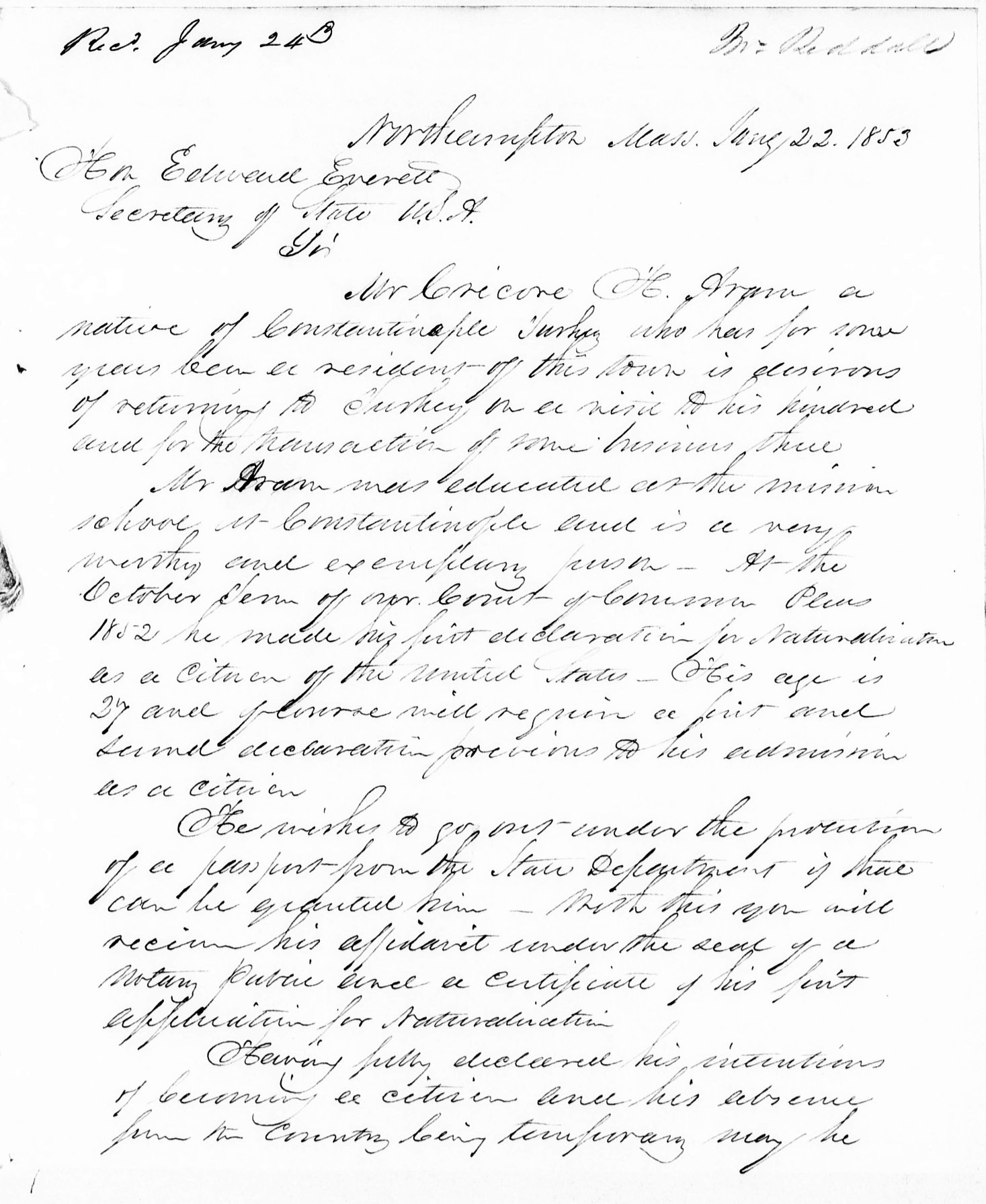
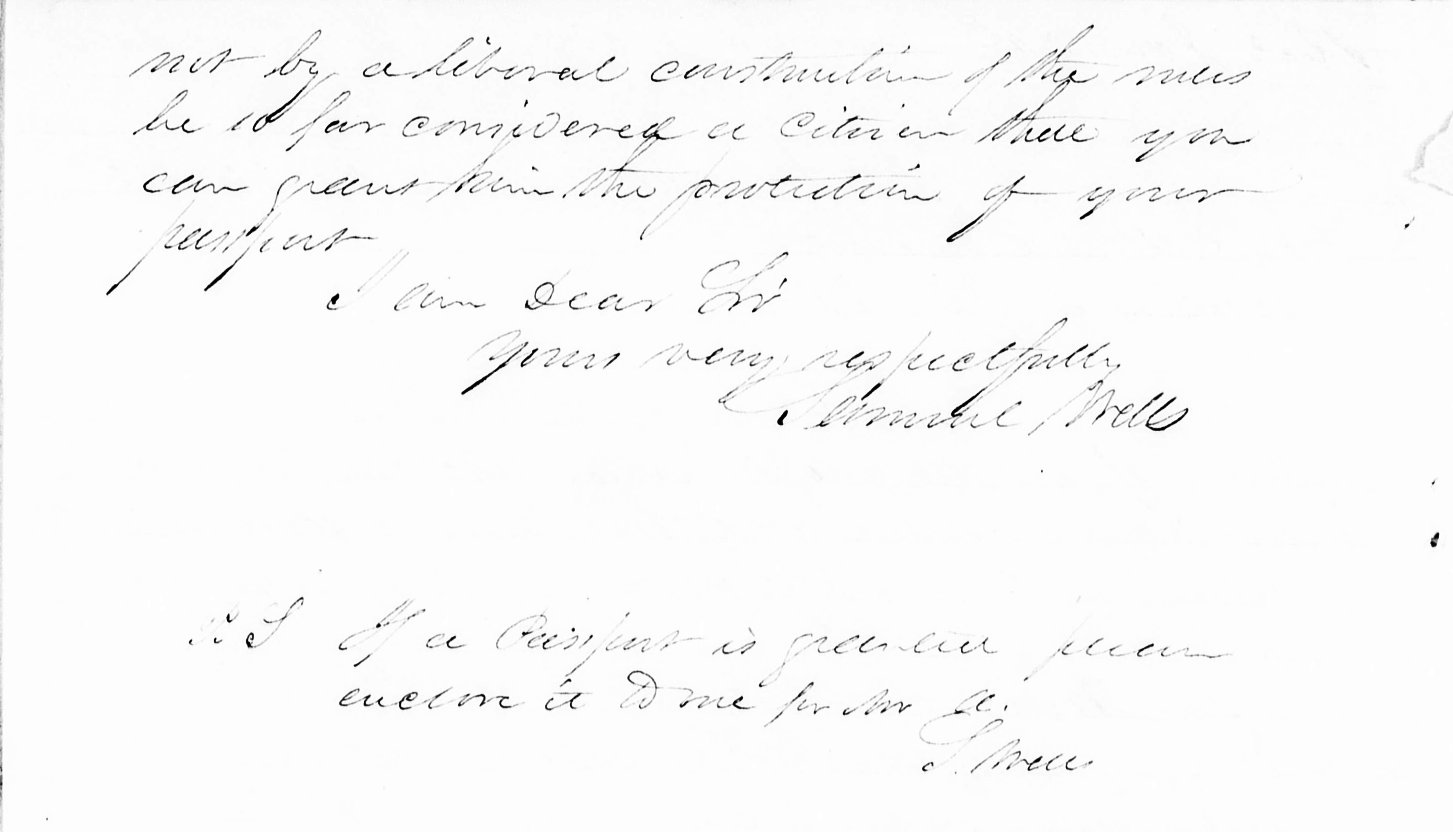
USA 1850 Federal Census Record (Cricore Aram in Northampton, Hampshire County, MA), with passport application (1853)In the censuses from 1850 through 1880, I have located 142 Armenians - 4 in 1850, 12 in 1860, 40 in 1870, and 86 in 1880. Of these, 80 were in the state of New York, 37 in Massachusetts, 10 in Pennsylvania, and the other 15 scattered across other states. I have probably missed a few, since they are harder to spot than in the later censuses (where it gives their "mother tongue"). I looked for those whose birthplace was Armenia or Turkey (in the index on Ancestry.com). Of those born in Turkey, I looked for "obvious" Armenian first names or last names (not a precise science). Many of the index entries were incorrect (birthplace of "Armenia" was actually "America", names misspelled, etc.).
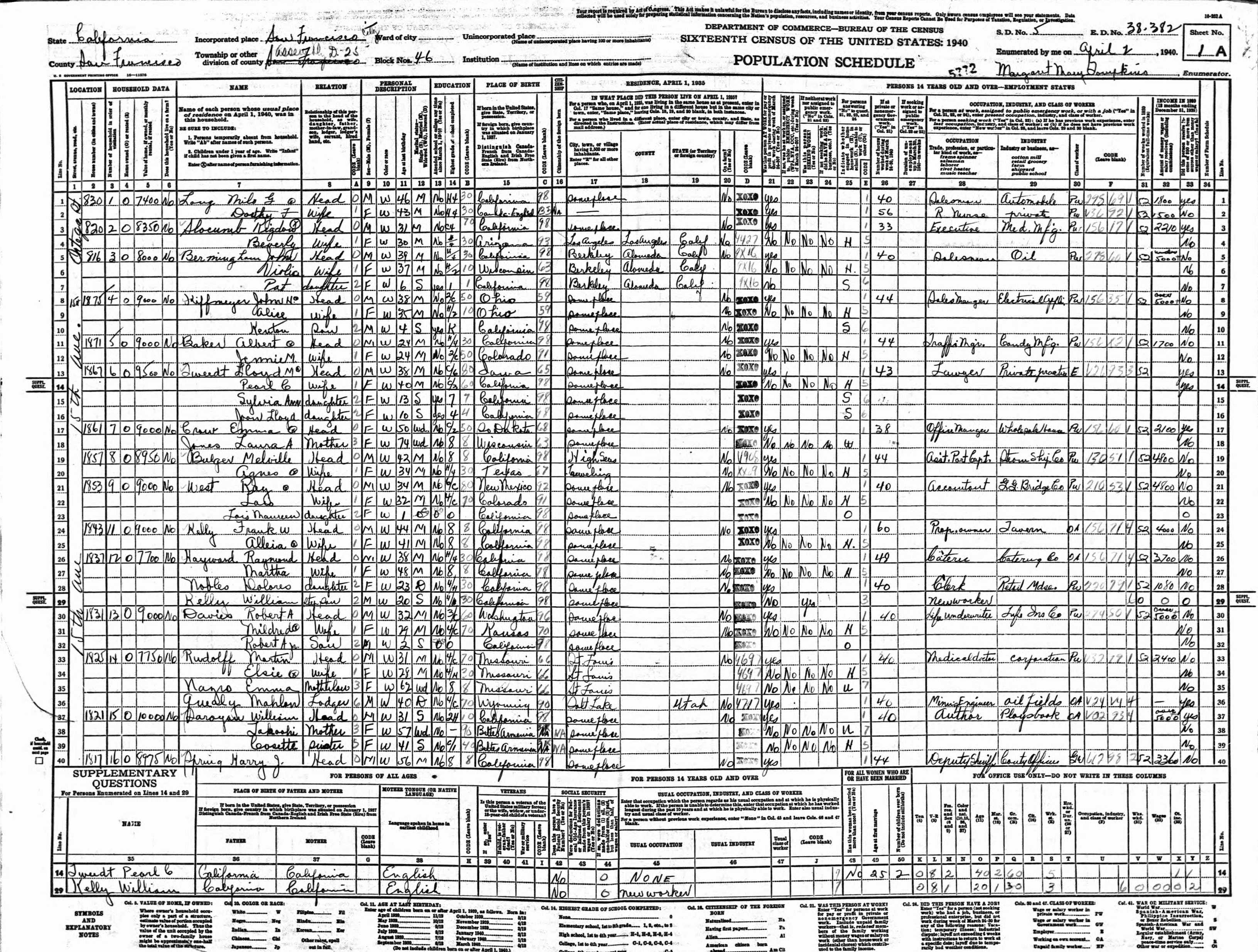
USA 1940 Federal Census Record (William Saroyan in San Francisco, CA)To access the online database, click below:
Export of Entire Database
This .csv file contains the entire online database. You may import this file into your own spreadsheet program or database to create your own reports or do your own analysis. The character set is utf-8 and the column separator is a semicolon (;).
Another very rich resource is the collection of naturalization applications relating to Armenians in the USA. These include two different forms: the Declaration of Intention (also known as "first papers") and the Petition for Naturalization. See http://www.archives.gov/research/naturalization/naturalization.html and https://familysearch.org/learn/wiki/en/United_States_Naturalization_and_Citizenship. The Declaration of Intention was filed first. Within seven years, the immigrant could apply for citizenship by filing a Petition for Naturalization. These two documents often contain facts not normally found elsewhere. Many of them reveal the immigrant's village of birth; some give the date and place of their marriage in the "old country" and the name of a spouse who didn't survive the genocide. Most of those applying for citizenship were men, although some women applied in the later years. Children of immigrants are also listed.
Starting in the late 1920s, naturalization applicants were required to affix their photograph to the Declaration of Intention. Here are some of them:
To access the online database, click below:
Export of Entire Database
This .csv file contains the entire online database. You may import this file into your own spreadsheet program or database to create your own reports or do your own analysis. The character set is utf-8 and the column separator is a semicolon (;).
USA passport applications relating to citizens of Armenian descent are especially important in the period immediately following the end of World War 1, as they document many of the genocide survivors coming to American to join their newly naturalized fathers or husbands. The form used for a passport application was based upon how that person claimed citizenship: (1) native-born, (2) naturalized, or (3) by spouse or parent (who was a citizen). Starting in the late 1910s, most passport applications were accompanied by a photo of the person or persons applying for the passport. The passport forms could include the names of several different roles - the applicant, his/her parent, his/her spouse, and their children.
To access the online database, click below:
Export of Entire Database
This .csv file contains the entire online database. You may import this file into your own spreadsheet program or database to create your own reports or do your own analysis. The character set is utf-8 and the column separator is a semicolon (;).
Advertisements placed in Armenian newspapers (published in North America) by Armenians wishing to locate friends and family who may have survived the genocide. These ads, many of them placed in the years immediately following the WW1 Armistice of 11 November 1918, typically included the name and address of the person (or persons) placing the ad, their place of origin (often the town or village of birth), and names and relationships of the people they are seeking. That information is included in these abstracts, along with the image of the original ad (printed in Armenian). The ads may contain other information such as a reward offered for information, or speculation about the survivors' last known whereabouts or potential "spottings". (That additional information is not typically included in these abstracts, but researchers who can read Armenian are encouraged to examine the images themselves to learn more.) These ads are especially valuable in that they sometimes give the names of native villages, spouses, children, and extended family not mentioned in other primary sources. Where possible, each of these records will be linked to the immigrant's ship manifest and to any other North American records relating to that individual.
To access the online database, click below:
Export of Entire Database
This .csv file contains the entire online database. You may import this file into your own spreadsheet program or database to create your own reports or do your own analysis. The character set is utf-8 and the column separator is a semicolon (;).
Another database is that of death certificates of Armenians who came to the USA and Canada through 1930, including children born to these couples who died before 1940. The death certificates are especially important in that they often provide the names of the parents of the decedent (often including the maiden surname of the mother). In some cases they also give the town or village of birth.
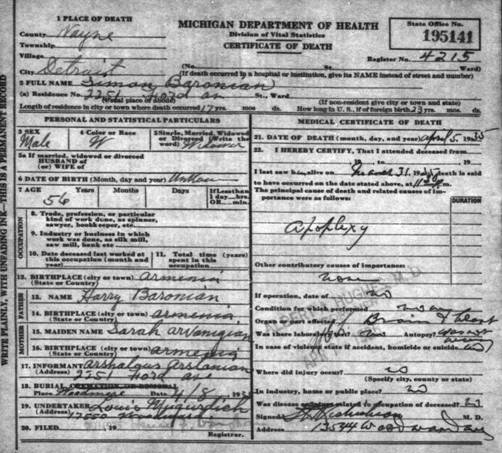
Detroit, Michigan Death CertificateTo access the online database, click below:
Export of Entire Database
This .csv file contains the entire online database. You may import this file into your own spreadsheet program or database to create your own reports or do your own analysis. The character set is utf-8 and the column separator is a semicolon (;).
Birth certificates of the children of these Armenian immigrants are also valuable in that they often provide the maiden (last) name of the mother. Occasionally, they provide the places of birth of the parents and (in the case of the province of Ontario in Canada) the date and place of the parents' marriage.
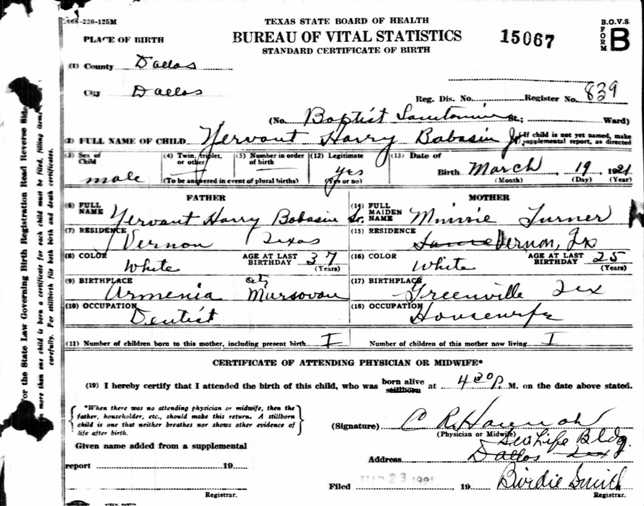
Dallas, Texas Birth CertificateTo access the online database, click below:
Export of Entire Database
This .csv file contains the entire online database. You may import this file into your own spreadsheet program or database to create your own reports or do your own analysis. The character set is utf-8 and the column separator is a semicolon (;).
Armenian DNA Project (Peter Hrechdakian, Hovann Simonian, & Mark Arslan, Administrators)
Vilayets of the Ottoman Empire
houshamadyan - A project to reconstruct Ottoman Armenian town and village life
Aram - An archives of books and manuscripts relating to Armenians (written in French and Armenian)
ISTG - Immigrant Ships Transcribers Guild
- Torn Between Two Lands, by Robert Mirak (Cambridge, MA: Harvard University Press, 1983)
- Like Our Mountains, A History of Armenians in Canada, by Isabel Kaprielian-Churchill (Montreal & Kingston, Canada: McGill-Queen's University Press, 2005)
- Armenia, A Historical Atlas, by Robert H. Hewsen (Chicago, IL: The University of Chicago Press, 2001)
- The Armenian Genocide, A Complete History, by Raymond Kévorkian (New York, NY: I. B. Tauris, 2011)
A Guide to Interpreting Passenger List Annotations (by Marian L. Smith, Historian, U.S. Immigration and Naturalization Service)
Ancestry.com - Immigration & Travel
Ellis Island Foundation
Stephen P. Morse Search Tools
First of all, I'd like to acknowledge my father's 1st-cousins Kevork "George" Arslanian and Hamazasp "Harry" Arslanian and their families for helping me learn about my Armenian heritage in the early 1970s. George and Harry (and Harry's wife Alice Baronian) patiently took the time to answer my numerous letters with question after question. My father's 2nd-cousins Vaskin "Vincent" Arslanian and Levon "Leon" Arslanian were also very helpful in sharing their memories of our family and their knowledge of the relationships. Without their help, much of the knowledge of my Arslanian family origins would have been lost forever.
Robert Mirak and Isabel Kaprielian-Churchill later inspired me with their fascinating works on the subject of Armenian immigration to North America. Reading their books spurred my interest in reading through the Ellis Island (New York) ship lists to try to identify immigrants from my paternal grandfather's district in the vilayet of Erzurum. During that project (in 2001), I met a number of other Armenians (some related to me) with similar interests who were willing to offer advice and information. I'd like to acknowledge them as well.
Robert Hewsen's Armenia, A Historical Atlas has proven invaluable in helping me locate places in late 19th- and early 20th-century historical Armenia. I am still fascinated by the maps and historical references in that beautiful volume.
More recently, through Peter Hrechdakian and Hovann Simonian and the Armenian DNA Project, I have been made aware of a much larger community of people with interest in Armenian history and genealogy. This has expanded my interest beyond just my own family's corner of (Ottoman) Armenia. I'm hoping that kicking off this ship list transcription project can eventually provide a lasting scholarly contribution to our knowledge of the Armenian people.
If you find this information useful and would like to contribute towards funding this research, please consider selecting one of the options below. This helps me pay for subscriptions to web sites (e.g., Ancestry.com, Newspapers.com), web hosting (GoDaddy.com and bluehost), reference materials (maps, books), supplies (paper, ink, binders, folders), time, and travel.
If you would like to comment on any information contained within, please send me an e-mail message at: contact@arslanmb.org. Additions and corrections are greatly appreciated.

Mark B. Arslan
© Mark B. Arslan, 2015
All Rights Reserved
No part of this website or any of its contents may be reproduced, copied, modified or adapted, without the prior written consent of the author, unless otherwise indicated for stand-alone materials.
You may share this website by any of the following means:
1. Providing a back-link or the URL of the content you wish to disseminate; or
2. You may quote extracts from the website with attribution to shiplists.html
For any other mode of sharing, please contact the author at the e-mail contact@arslanmb.org
Commercial use and distribution of the contents of the website is not allowed without express and prior written consent of the author.